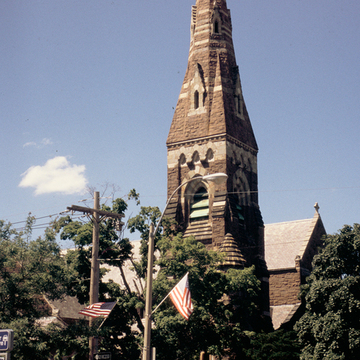After leaving its earlier home in Brookline Village, Harvard Church (210 Harvard Street) erected in 1873 the largest and most architecturally distinctive ecclesiastical building in Brookline. The congregation chose New York architect Edward Tuckerman Potter because they admired his Coit Memorial Church in Hartford, Connecticut. As the first American architect to introduce Venetian Gothic, Potter became well known for his polychromatic designs. The colorful use of sandstone with both white and green limestone from Pennsylvania distinguishes this building. After a serious fire in 1931, the congregation chose to maintain the exterior while rebuilding the interior, with Allen and Collens as architects.
Following the construction of Harvard Church, a great many unusual architect-designed homes arose on Harvard and the nearby streets extending west from the Longwood neighborhood (BR1). Although apartment blocks or Georgian- and Tudor-style tract housing have mostly replaced these houses, two adjacent Sewall Avenue residences suggest the earlier character of the neighborhood. In 1885, S. Edwin Tobey designed the George Dexter House (76–77 Sewall Avenue), a typical example of his free interpretations of Queen Anne and Colonial Revival forms. George Dexter's family firm, Dexter Brothers Paint and Oil Company, frequently used such houses to advertise their products. Next door is the 1899 Charles Flagg House (70 Sewall Avenue) by Julius Schweinfurth, an architect better known for his Classical Revival designs but here combining Shingle Style and Arts and Crafts motifs.


